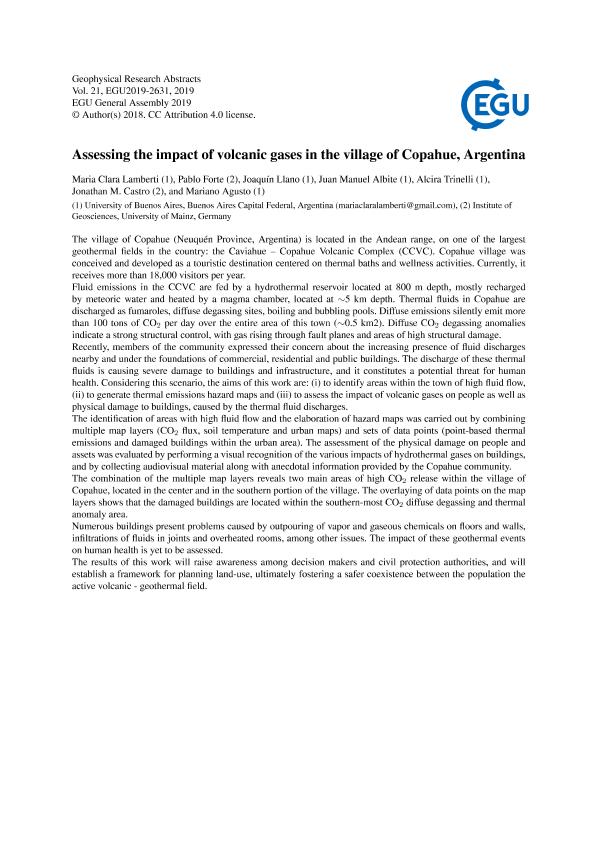Mostrar el registro sencillo del ítem
dc.contributor.author
Lamberti, María Clara Isabel

dc.contributor.author
Forte, Pablo Brian

dc.contributor.author
Llano, Joaquin

dc.contributor.author
Albite, Juan Manuel

dc.contributor.author
Trinelli, María Alcira

dc.contributor.author
Castro, J.
dc.contributor.author
Agusto, Mariano Roberto

dc.date.available
2022-11-16T15:54:25Z
dc.date.issued
2019
dc.identifier.citation
Assessing the impact of volcanic gases in the village of Copahue, Argentina; EGU General Assembly 2019; Viena; Austria; 2019; 1-1
dc.identifier.uri
http://hdl.handle.net/11336/178009
dc.description.abstract
The village of Copahue (Neuquén Province, Argentina) is located in the Andean range, on one of the largest geothermal fields in the country: the Caviahue ? Copahue Volcanic Complex (CCVC). Copahue village was conceived and developed as a touristic destination centered on thermal baths and wellness activities. Currently, it receives more than 18,000 visitors per year.Fluid emissions in the CCVC are fed by a hydrothermal reservoir located at 800 m depth, mostly recharged by meteoric water and heated by a magma chamber, located at ~5 km depth. Thermal fluids in Copahue are discharged as fumaroles, diffuse degassing sites, boiling and bubbling pools. Diffuse emissions silently emit more than 100 tons of CO2 per day over the entire area of this town (~0.5 km2). Diffuse CO2 degassing anomalies indicate a strong structural control, with gas rising through fault planes and areas of high structural damage.Recently, members of the community expressed their concern about the increasing presence of fluid discharges nearby and under the foundations of commercial, residential and public buildings. The discharge of these thermal fluids is causing severe damage to buildings and infrastructure, and it constitutes a potential threat for human health. Considering this scenario, the aims of this work are: (i) to identify areas within the town of high fluid flow, (ii) to generate thermal emissions hazard maps and (iii) to assess the impact of volcanic gases on people as well as physical damage to buildings, caused by the thermal fluid discharges. The identification of areas with high fluid flow and the elaboration of hazard maps was carried out by combining multiple map layers (CO2 flux, soil temperature and urban maps) and sets of data points (point-based thermal emissions and damaged buildings within the urban area). The assessment of the physical damage on people and assets was evaluated by performing a visual recognition of the various impacts of hydrothermal gases on buildings, and by collecting audiovisual material along with anecdotal information provided by the Copahue community.The combination of the multiple map layers reveals two main areas of high CO2 release within the village of Copahue, located in the center and in the southern portion of the village. The overlaying of data points on the map layers shows that the damaged buildings are located within the southern-most CO2 diffuse degassing and thermal anomaly area.Numerous buildings present problems caused by outpouring of vapor and gaseous chemicals on floors and walls, infiltrations of fluids in joints and overheated rooms, among other issues. The impact of these geothermal events on human health is yet to be assessed.The results of this work will raise awareness among decision makers and civil protection authorities, and will establish a framework for planning land-use, ultimately fostering a safer coexistence between the population the active volcanic - geothermal field.
dc.format
application/pdf
dc.language.iso
eng
dc.publisher
Copernicus Publications

dc.rights
info:eu-repo/semantics/openAccess
dc.rights.uri
https://creativecommons.org/licenses/by/2.5/ar/
dc.subject
Impact
dc.subject
Gases
dc.subject
Copahue
dc.subject
Damage
dc.subject.classification
Otras Ciencias de la Tierra y relacionadas con el Medio Ambiente

dc.subject.classification
Ciencias de la Tierra y relacionadas con el Medio Ambiente

dc.subject.classification
CIENCIAS NATURALES Y EXACTAS

dc.title
Assessing the impact of volcanic gases in the village of Copahue, Argentina
dc.type
info:eu-repo/semantics/publishedVersion
dc.type
info:eu-repo/semantics/conferenceObject
dc.type
info:ar-repo/semantics/documento de conferencia
dc.date.updated
2022-11-09T18:43:33Z
dc.journal.volume
21
dc.journal.pagination
1-1
dc.journal.pais
Austria

dc.journal.ciudad
Viena
dc.description.fil
Fil: Lamberti, María Clara Isabel. Consejo Nacional de Investigaciones Científicas y Técnicas. Oficina de Coordinación Administrativa Ciudad Universitaria. Instituto de Estudios Andinos "Don Pablo Groeber". Universidad de Buenos Aires. Facultad de Ciencias Exactas y Naturales. Instituto de Estudios Andinos "Don Pablo Groeber"; Argentina
dc.description.fil
Fil: Forte, Pablo Brian. Consejo Nacional de Investigaciones Científicas y Técnicas. Oficina de Coordinación Administrativa Ciudad Universitaria. Instituto de Estudios Andinos "Don Pablo Groeber". Universidad de Buenos Aires. Facultad de Ciencias Exactas y Naturales. Instituto de Estudios Andinos "Don Pablo Groeber"; Argentina
dc.description.fil
Fil: Llano, Joaquin. Consejo Nacional de Investigaciones Científicas y Técnicas. Oficina de Coordinación Administrativa Ciudad Universitaria. Instituto de Estudios Andinos "Don Pablo Groeber". Universidad de Buenos Aires. Facultad de Ciencias Exactas y Naturales. Instituto de Estudios Andinos "Don Pablo Groeber"; Argentina
dc.description.fil
Fil: Albite, Juan Manuel. Consejo Nacional de Investigaciones Científicas y Técnicas. Oficina de Coordinación Administrativa Ciudad Universitaria. Instituto de Geociencias Básicas, Aplicadas y Ambientales de Buenos Aires. Universidad de Buenos Aires. Facultad de Ciencias Exactas y Naturales. Instituto de Geociencias Básicas, Aplicadas y Ambientales de Buenos Aires; Argentina
dc.description.fil
Fil: Trinelli, María Alcira. Consejo Nacional de Investigaciones Científicas y Técnicas. Oficina de Coordinación Administrativa Ciudad Universitaria. Instituto de Geociencias Básicas, Aplicadas y Ambientales de Buenos Aires. Universidad de Buenos Aires. Facultad de Ciencias Exactas y Naturales. Instituto de Geociencias Básicas, Aplicadas y Ambientales de Buenos Aires; Argentina
dc.description.fil
Fil: Castro, J.. Johannes Gutenberg Universitat Mainz; Alemania
dc.description.fil
Fil: Agusto, Mariano Roberto. Consejo Nacional de Investigaciones Científicas y Técnicas. Oficina de Coordinación Administrativa Ciudad Universitaria. Instituto de Estudios Andinos "Don Pablo Groeber". Universidad de Buenos Aires. Facultad de Ciencias Exactas y Naturales. Instituto de Estudios Andinos "Don Pablo Groeber"; Argentina
dc.relation.alternativeid
info:eu-repo/semantics/altIdentifier/url/https://egu2019.eu/EGU2019_information_and_floor_plans.pdf
dc.conicet.rol
Autor

dc.conicet.rol
Autor

dc.conicet.rol
Autor

dc.conicet.rol
Autor

dc.conicet.rol
Autor

dc.conicet.rol
Autor

dc.conicet.rol
Autor

dc.coverage
Internacional
dc.type.subtype
Congreso
dc.description.nombreEvento
EGU General Assembly 2019
dc.date.evento
2019-04-07
dc.description.ciudadEvento
Viena
dc.description.paisEvento
Austria

dc.type.publicacion
Journal
dc.description.institucionOrganizadora
European Geosciences Union
dc.source.revista
Geophysical Research Abstracts
dc.date.eventoHasta
2019-04-12
dc.type
Congreso
Archivos asociados
